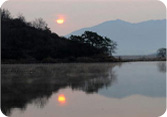World Heritage
Tentative List
- Kangjingun Kiln Sites (1994)
- Mt.Soraksan Nature Reserve (1994)
- Sites of fossilized dinosaurs throughout the Southern seacoast (2002)
- Salterns (2010)
- Southwestern Coast Tidal Flats (2010)
- Daegokcheon Stream Petroglyphs (2010)
- Ancient Mountain Fortresses in Central Korea (2010)
- Oeam Village (2011)
- Naganeupseong, Town Fortress and Village (2011)
- Upo Wetland (2011)
- Seoul City Wall (2012)
- Stone Buddhas and Pagodas at Hwasun Unjusa Temple(2017)
- Gaya Tumuli (2019)
 Upo Wetland located in Changnyeong-gun County, Gyeongsangnam-do Province, is the largest riverine wetland in the Republic of Korea with a well preserved natural
environment. The area of Upo Wetland spans about 2.3km2 and many smaller wetlands are scattered around. In recognition of its values as a migratory bird habitat, the wetland has been inscribed on the Ramsar List of Wetlands of
International Importance in 1998, and during the 10th Meeting of the Conference of the Contracting Parties (COP10) held in 2008, many experts visited the wetland.
Upo Wetland located in Changnyeong-gun County, Gyeongsangnam-do Province, is the largest riverine wetland in the Republic of Korea with a well preserved natural
environment. The area of Upo Wetland spans about 2.3km2 and many smaller wetlands are scattered around. In recognition of its values as a migratory bird habitat, the wetland has been inscribed on the Ramsar List of Wetlands of
International Importance in 1998, and during the 10th Meeting of the Conference of the Contracting Parties (COP10) held in 2008, many experts visited the wetland.
The creation of Upo Wetland dates back to when the Korean Peninsula was formed. It has provided people with a means of livelihood, while retaining its well-preserved primitive ecosystem. In addition, the wetland plays an important role as a habitat for more than 10 endangered species, a fact that draws global attention. The beautiful landscape surrounding the wetland area increases the invaluable aspect of the wetland as a rich repository of the primitive ecosystem.
Recent archaeological discoveries such as an old wooden boat found in Bibong-ri Shell Mound site confirm that in the past the inland area of Changnyeong region was affected by the intrusion of sea water that flowed along the Nakdonggang River. The small riverine marshes surrounding Upo were also created in this process. The shell mounds are very important evidence in understanding the creation of Upo and its adjacent wetlands. The wooden boat found in the shell mound is estimated to be 7500 years old, which places it amongst the world's oldest boats such as those found in Kuwait and China (8000-7000 years). The shell mounds, a pit for storing acorns and fishery tools, are believed to have been used by people in communities who lived along the seashore, being evidence of prehistoric lifestyles in this area. Besides, other archeological discoveries including stone pestles, grinding stones, wooden goods, pottery shards and a mesh bag significantly enhances the site's archeological value.
These archeological relics prove the previous interaction with sea water in this area which is now regarded as a freshwater zone, and also provides a glimpse of lifestyles of the Neolithic era. It also reveals how the relationship between the wetland and human beings has changed with the flow of time.



 >
>